Inchul Hwang
Investigating Disentanglement in a Phoneme-level Speech Codec for Prosody Modeling
Sep 13, 2024



Abstract:Most of the prevalent approaches in speech prosody modeling rely on learning global style representations in a continuous latent space which encode and transfer the attributes of reference speech. However, recent work on neural codecs which are based on Residual Vector Quantization (RVQ) already shows great potential offering distinct advantages. We investigate the prosody modeling capabilities of the discrete space of such an RVQ-VAE model, modifying it to operate on the phoneme-level. We condition both the encoder and decoder of the model on linguistic representations and apply a global speaker embedding in order to factor out both phonetic and speaker information. We conduct an extensive set of investigations based on subjective experiments and objective measures to show that the phoneme-level discrete latent representations obtained this way achieves a high degree of disentanglement, capturing fine-grained prosodic information that is robust and transferable. The latent space turns out to have interpretable structure with its principal components corresponding to pitch and energy.
Improved Text Emotion Prediction Using Combined Valence and Arousal Ordinal Classification
Apr 02, 2024
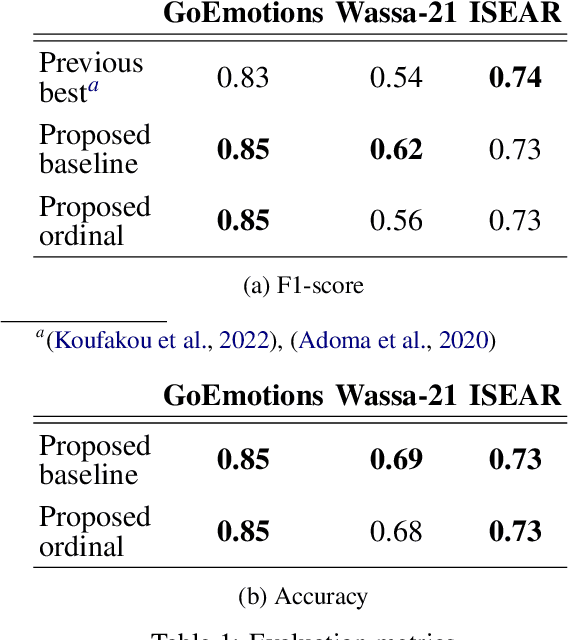
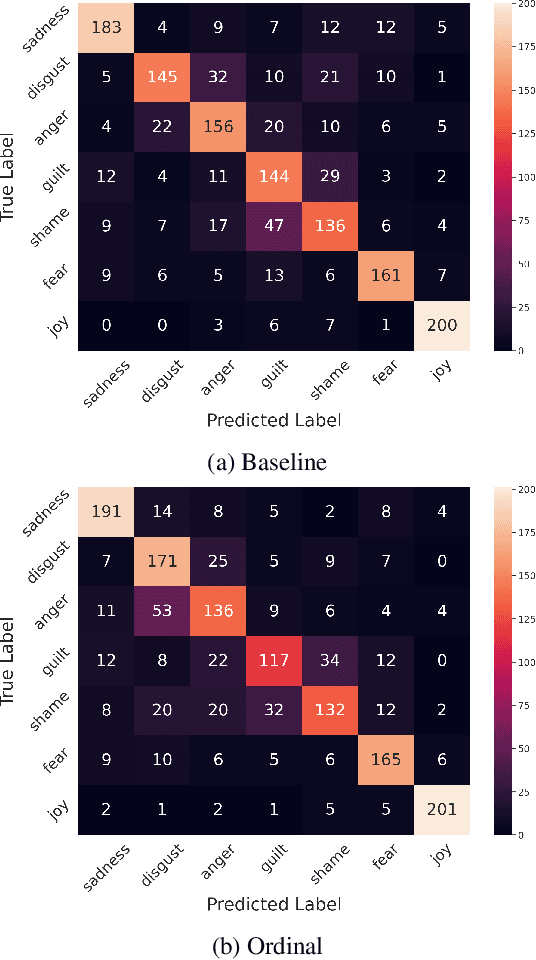
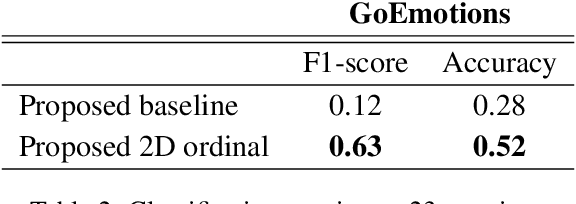
Abstract:Emotion detection in textual data has received growing interest in recent years, as it is pivotal for developing empathetic human-computer interaction systems. This paper introduces a method for categorizing emotions from text, which acknowledges and differentiates between the diversified similarities and distinctions of various emotions. Initially, we establish a baseline by training a transformer-based model for standard emotion classification, achieving state-of-the-art performance. We argue that not all misclassifications are of the same importance, as there are perceptual similarities among emotional classes. We thus redefine the emotion labeling problem by shifting it from a traditional classification model to an ordinal classification one, where discrete emotions are arranged in a sequential order according to their valence levels. Finally, we propose a method that performs ordinal classification in the two-dimensional emotion space, considering both valence and arousal scales. The results show that our approach not only preserves high accuracy in emotion prediction but also significantly reduces the magnitude of errors in cases of misclassification.
Low-Resource Cross-Domain Singing Voice Synthesis via Reduced Self-Supervised Speech Representations
Feb 02, 2024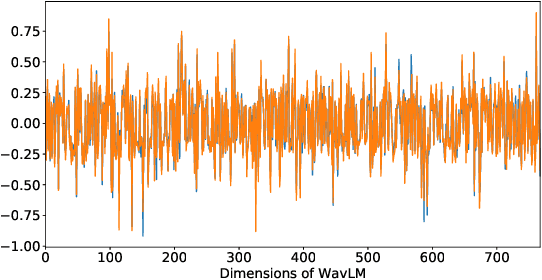

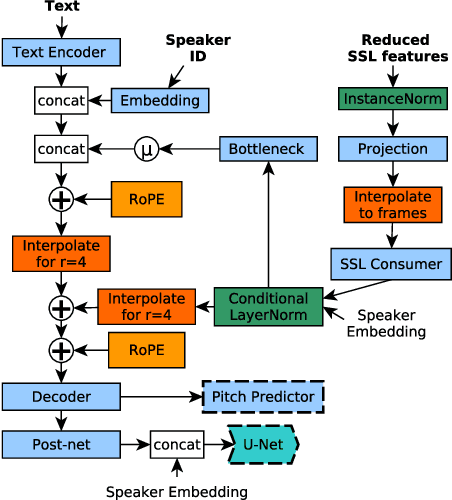
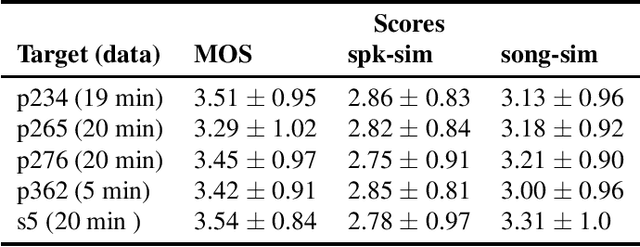
Abstract:In this paper, we propose a singing voice synthesis model, Karaoker-SSL, that is trained only on text and speech data as a typical multi-speaker acoustic model. It is a low-resource pipeline that does not utilize any singing data end-to-end, since its vocoder is also trained on speech data. Karaoker-SSL is conditioned by self-supervised speech representations in an unsupervised manner. We preprocess these representations by selecting only a subset of their task-correlated dimensions. The conditioning module is indirectly guided to capture style information during training by multi-tasking. This is achieved with a Conformer-based module, which predicts the pitch from the acoustic model's output. Thus, Karaoker-SSL allows singing voice synthesis without reliance on hand-crafted and domain-specific features. There are also no requirements for text alignments or lyrics timestamps. To refine the voice quality, we employ a U-Net discriminator that is conditioned on the target speaker and follows a Diffusion GAN training scheme.
Predicting phoneme-level prosody latents using AR and flow-based Prior Networks for expressive speech synthesis
Nov 02, 2022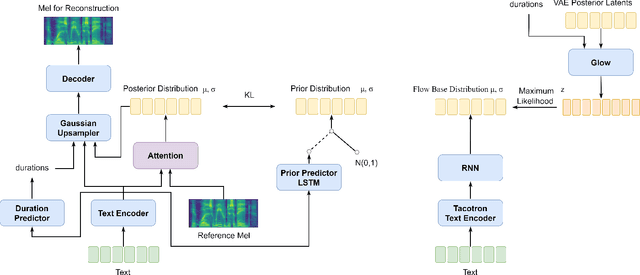
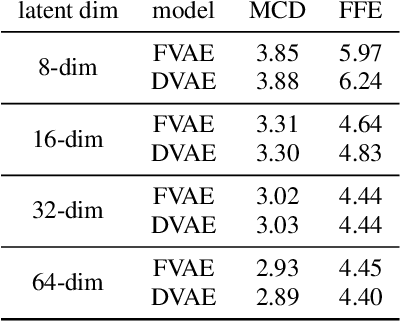
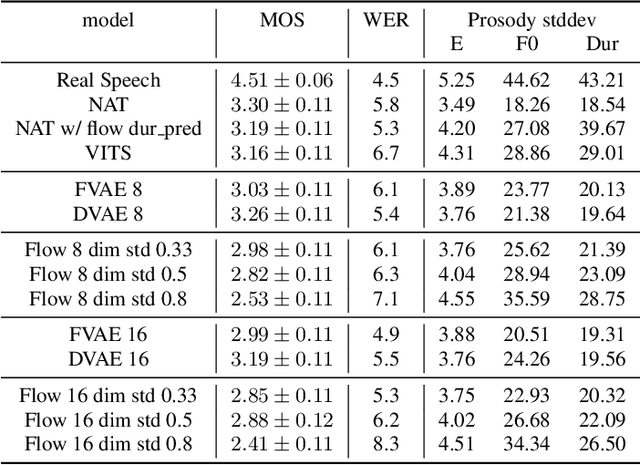
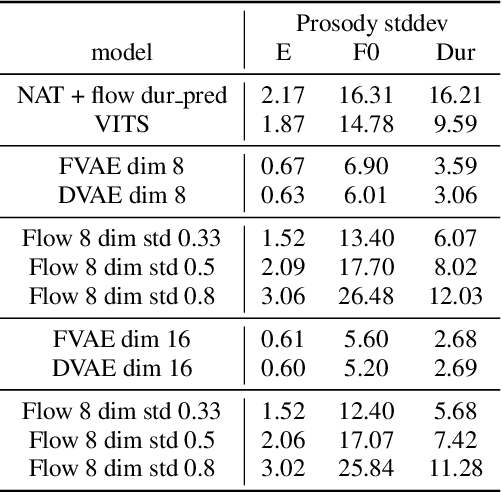
Abstract:A large part of the expressive speech synthesis literature focuses on learning prosodic representations of the speech signal which are then modeled by a prior distribution during inference. In this paper, we compare different prior architectures at the task of predicting phoneme level prosodic representations extracted with an unsupervised FVAE model. We use both subjective and objective metrics to show that normalizing flow based prior networks can result in more expressive speech at the cost of a slight drop in quality. Furthermore, we show that the synthesized speech has higher variability, for a given text, due to the nature of normalizing flows. We also propose a Dynamical VAE model, that can generate higher quality speech although with decreased expressiveness and variability compared to the flow based models.
Generating Gender-Ambiguous Text-to-Speech Voices
Nov 01, 2022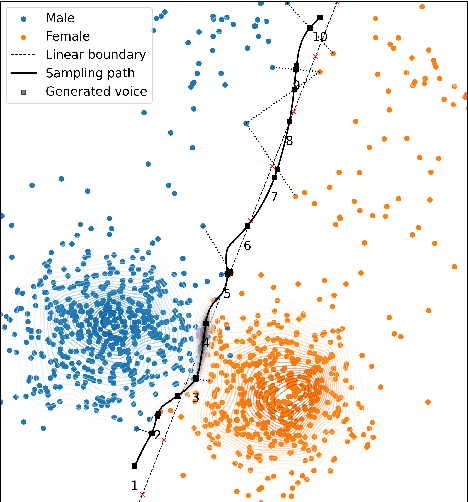


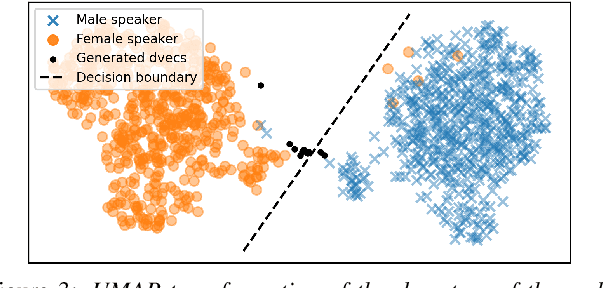
Abstract:The gender of a voice assistant or any voice user interface is a central element of its perceived identity. While a female voice is a common choice, there is an increasing interest in alternative approaches where the gender is ambiguous rather than clearly identifying as female or male. This work addresses the task of generating gender-ambiguous text-to-speech (TTS) voices that do not correspond to any existing person. This is accomplished by sampling from a latent speaker embeddings' space that was formed while training a multilingual, multi-speaker TTS system on data from multiple male and female speakers. Various options are investigated regarding the sampling process. In our experiments, the effects of different sampling choices on the gender ambiguity and the naturalness of the resulting voices are evaluated. The proposed method is shown able to efficiently generate novel speakers that are superior to a baseline averaged speaker embedding. To our knowledge, this is the first systematic approach that can reliably generate a range of gender-ambiguous voices to meet diverse user requirements.
Investigating Content-Aware Neural Text-To-Speech MOS Prediction Using Prosodic and Linguistic Features
Nov 01, 2022
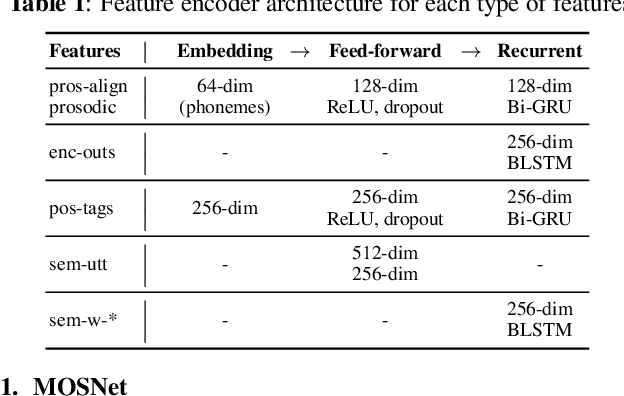
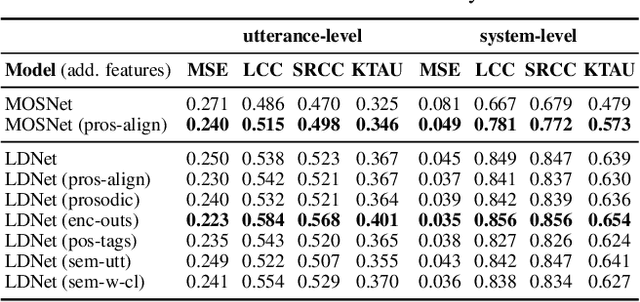
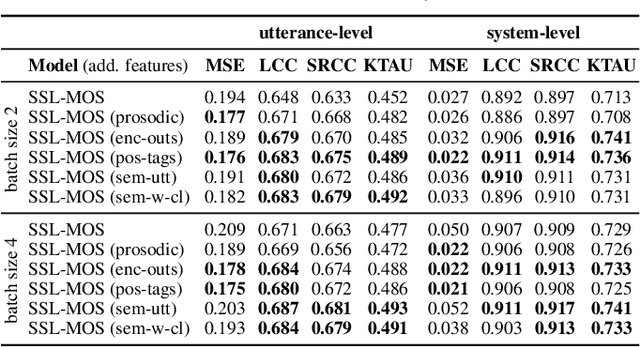
Abstract:Current state-of-the-art methods for automatic synthetic speech evaluation are based on MOS prediction neural models. Such MOS prediction models include MOSNet and LDNet that use spectral features as input, and SSL-MOS that relies on a pretrained self-supervised learning model that directly uses the speech signal as input. In modern high-quality neural TTS systems, prosodic appropriateness with regard to the spoken content is a decisive factor for speech naturalness. For this reason, we propose to include prosodic and linguistic features as additional inputs in MOS prediction systems, and evaluate their impact on the prediction outcome. We consider phoneme level F0 and duration features as prosodic inputs, as well as Tacotron encoder outputs, POS tags and BERT embeddings as higher-level linguistic inputs. All MOS prediction systems are trained on SOMOS, a neural TTS-only dataset with crowdsourced naturalness MOS evaluations. Results show that the proposed additional features are beneficial in the MOS prediction task, by improving the predicted MOS scores' correlation with the ground truths, both at utterance-level and system-level predictions.
Learning utterance-level representations through token-level acoustic latents prediction for Expressive Speech Synthesis
Nov 01, 2022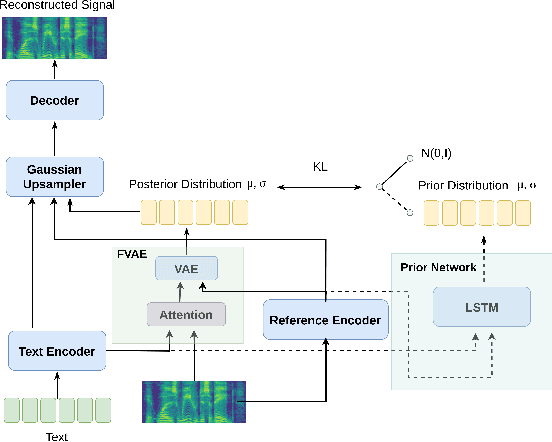
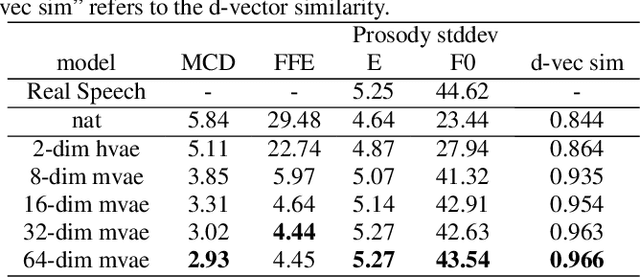
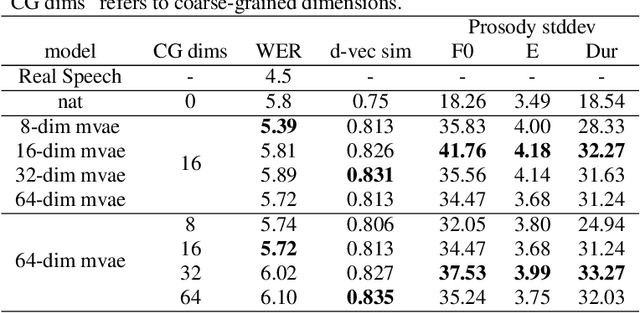

Abstract:This paper proposes an Expressive Speech Synthesis model that utilizes token-level latent prosodic variables in order to capture and control utterance-level attributes, such as character acting voice and speaking style. Current works aim to explicitly factorize such fine-grained and utterance-level speech attributes into different representations extracted by modules that operate in the corresponding level. We show that the fine-grained latent space also captures coarse-grained information, which is more evident as the dimension of latent space increases in order to capture diverse prosodic representations. Therefore, a trade-off arises between the diversity of the token-level and utterance-level representations and their disentanglement. We alleviate this issue by first capturing rich speech attributes into a token-level latent space and then, separately train a prior network that given the input text, learns utterance-level representations in order to predict the phoneme-level, posterior latents extracted during the previous step. Both qualitative and quantitative evaluations are used to demonstrate the effectiveness of the proposed approach. Audio samples are available in our demo page.
Cross-lingual Text-To-Speech with Flow-based Voice Conversion for Improved Pronunciation
Oct 31, 2022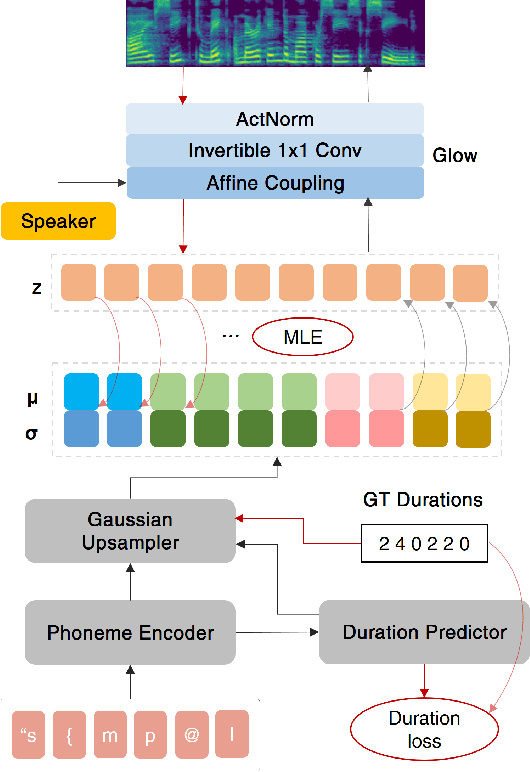
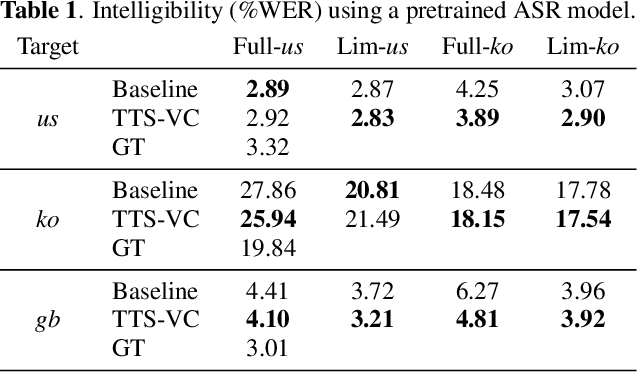

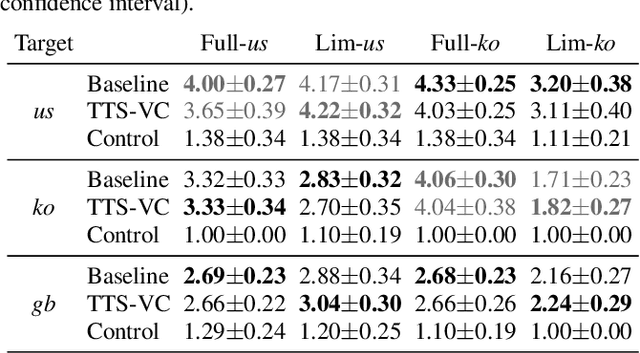
Abstract:This paper presents a method for end-to-end cross-lingual text-to-speech (TTS) which aims to preserve the target language's pronunciation regardless of the original speaker's language. The model used is based on a non-attentive Tacotron architecture, where the decoder has been replaced with a normalizing flow network conditioned on the speaker identity, allowing both TTS and voice conversion (VC) to be performed by the same model due to the inherent linguistic content and speaker identity disentanglement. When used in a cross-lingual setting, acoustic features are initially produced with a native speaker of the target language and then voice conversion is applied by the same model in order to convert these features to the target speaker's voice. We verify through objective and subjective evaluations that our method can have benefits compared to baseline cross-lingual synthesis. By including speakers averaging 7.5 minutes of speech, we also present positive results on low-resource scenarios.
Faster Re-translation Using Non-Autoregressive Model For Simultaneous Neural Machine Translation
Dec 29, 2020

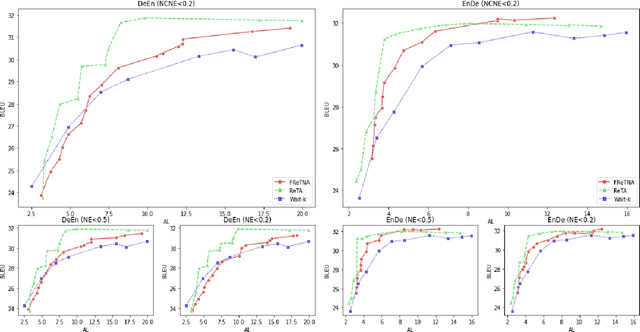
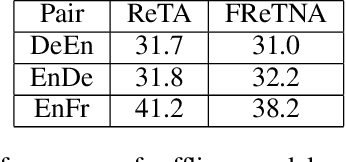
Abstract:Recently, simultaneous translation has gathered a lot of attention since it enables compelling applications such as subtitle translation for a live event or real-time video-call translation. Some of these translation applications allow editing of partial translation giving rise to re-translation approaches. The current re-translation approaches are based on autoregressive sequence generation models (ReTA), which generate tar-get tokens in the (partial) translation sequentially. The multiple re-translations with sequential generation inReTAmodelslead to an increased inference time gap between the incoming source input and the corresponding target output as the source input grows. Besides, due to the large number of inference operations involved, the ReTA models are not favorable for resource-constrained devices. In this work, we propose a faster re-translation system based on a non-autoregressive sequence generation model (FReTNA) to overcome the aforementioned limitations. We evaluate the proposed model on multiple translation tasks and our model reduces the inference times by several orders and achieves a competitive BLEUscore compared to the ReTA and streaming (Wait-k) models.The proposed model reduces the average computation time by a factor of 20 when compared to the ReTA model by incurring a small drop in the translation quality. It also outperforms the streaming-based Wait-k model both in terms of computation time (1.5 times lower) and translation quality.
Ensemble-Based Deep Reinforcement Learning for Chatbots
Aug 27, 2019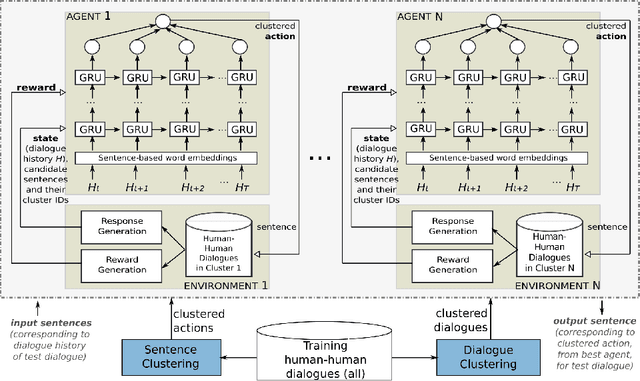
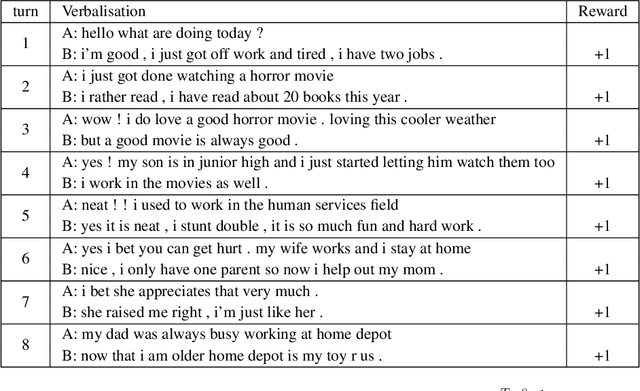
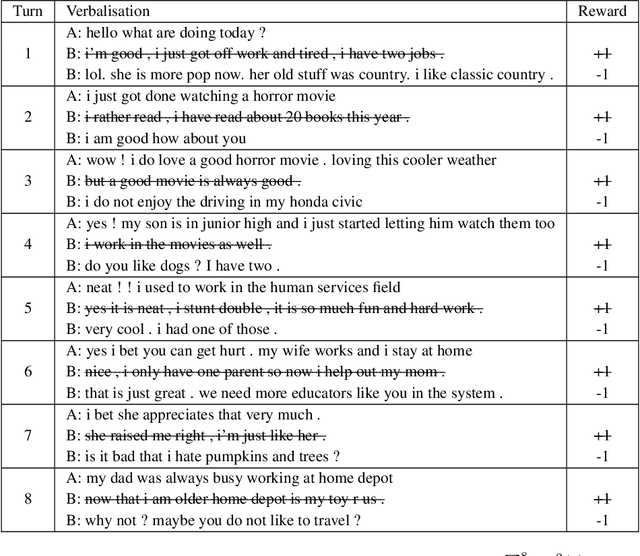
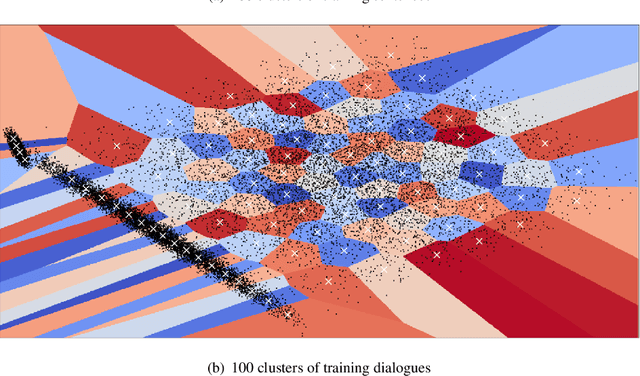
Abstract:Trainable chatbots that exhibit fluent and human-like conversations remain a big challenge in artificial intelligence. Deep Reinforcement Learning (DRL) is promising for addressing this challenge, but its successful application remains an open question. This article describes a novel ensemble-based approach applied to value-based DRL chatbots, which use finite action sets as a form of meaning representation. In our approach, while dialogue actions are derived from sentence clustering, the training datasets in our ensemble are derived from dialogue clustering. The latter aim to induce specialised agents that learn to interact in a particular style. In order to facilitate neural chatbot training using our proposed approach, we assume dialogue data in raw text only -- without any manually-labelled data. Experimental results using chitchat data reveal that (1) near human-like dialogue policies can be induced, (2) generalisation to unseen data is a difficult problem, and (3) training an ensemble of chatbot agents is essential for improved performance over using a single agent. In addition to evaluations using held-out data, our results are further supported by a human evaluation that rated dialogues in terms of fluency, engagingness and consistency -- which revealed that our proposed dialogue rewards strongly correlate with human judgements.
 Add to Chrome
Add to Chrome Add to Firefox
Add to Firefox Add to Edge
Add to Edge